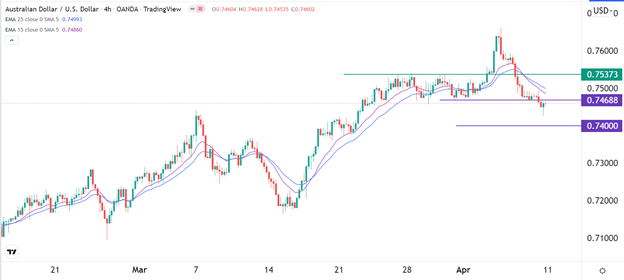Bearish View
- Sell the AUD/USD pair and set a take-profit at 0.7400.
- Add a stop-loss at 0.7520.
- Timeline: 1-2 days.
Bullish View
- Set a buy-stop at 0.7475 and a take-profit at 0.7550.
- Add a stop-loss at 0,7400.
The AUD/USD pair lost its bullish momentum as the Federal Reserve and Reserve Bank of Australia (RBA) convergence emerged. After initially rising to a high of 0.7661 last week, the pair declined by more than 2.6%.
Fed and RBA Convergence
The RBA has been one of the most mysterious central banks in the emerging markets. In 2021, the bank insisted that it will start hiking interest rates in 2023 or 2024. It continued this tone in its February meeting.
However, last week, the RBA signaled that it was losing patience with inflation. As a result, the bank’s statement provided hints that it will start hiking interest rates in its June meeting. This will be a notable period since it will come after the country’s election.
The hawkish RBA sentiment coincided with that of the Federal Reserve. The minutes published on Wednesday showed that the bank’s officials were comfortable with additional interest rate hikes. Also, the bank sent hints that it will start a quantitative tightening (QT) process. In this, it will start reducing its balance sheet by about $75 billion per month.
Fed speakers like Mary Daly, Lael Brainard, and James Bullard also sounded supportive of more rate hikes and QT. Brainard was a notable speaker considering that she is one of the most dovish officials in the bank.
The AUD/USD pair also declined after the Covid-19 crisis in China continued. The country’s government has announced strong lockdowns in key cities like Shanghai. As a result, many companies like Tesla and some Apple suppliers have been forced to close their operations.
The next key catalyst for the pair will be the coming American consumer inflation data scheduled for Wednesday, Economists expect the data to show that the headline and core inflation jumped sharply in March.
AUD/USD Forecast
The AUD/USD pair rose sharply after the RBA interest rate decision. It then quickly erased those gains since the hawkish sentiment was priced in. The pair is now trading at 0.7460, which is slightly below the 25-period and 15-period exponential moving averages. It has also dropped below the important resistance level at 0.7537, which was the highest points on March 25th and 30th. Notably, it is a few pips below 0.7468.
Therefore, the pair will likely continue falling as bears target the next key support level at 0.7400 ahead of the US inflation data.

